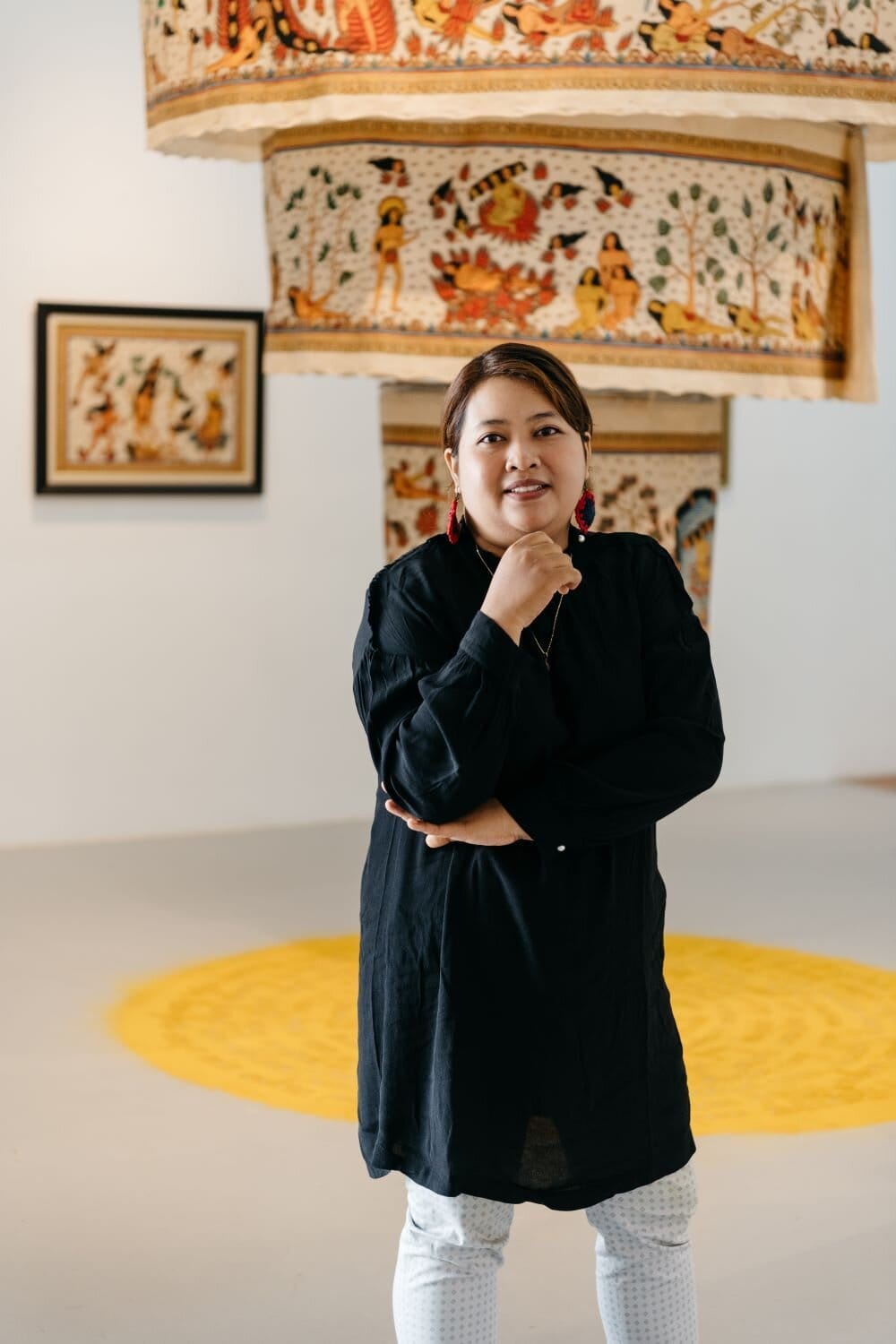Born in 1990 in Tabanan, Bali, Citra Sasmita studied literature at Udayana University and physics at Ganesha University. She belongs to a family of performing artists, and after completing her education, she pursued her dream of becoming an artist and started working as an illustrator for the Bali Post.This led to her taking an interest in the traditional form of Kamasam paintings and identifying this style as being biased towards the male gender, ignoring the role of women in Balinese culture and religion.
The Kamasam paintings originated from the village of Kamasam in Bali and were an exaggerated form of storytelling drawn and painted over processed bark paper to decorate temples and residences of the aristocrats. Taking inspiration from the traditional Balinese art form of the Kamasam paintings, Sasmita seeks to challenge normative gender constructs. The traditional Kamasam paintings depict more than one story that was inspired by Balinese folklore and the Hindu religion. This is much different from contemporary art, where there is usually one focal point and the viewer can decipher a singular narrative or follow a specific storyline.

By reimagining the Kamasam form of painting, Sasmita brings to light the authoritarian history of Bali, where the role of women in society was ignored. The paintings elaborated on religious tales revolving solely around male figures and male gods. Sasmita’s art aligns with the United Nations Sustainable Development Goals, notably that of Gender Equality. Her efforts seem to acknowledge the role of women in a functioning society as well as recognize them as divine figures and deities, almost as if rewriting history itself.
The Kamasam paintings are unique in their style as they aim to create a bridge between the world of humans and the divine gods. These paintings also lack any sense of landscape, and the figures are positioned on a flat surface. Sasmita acknowledged that the Kamasam paintings traditionally only depict male figures in their narration. Taking this as inspiration and conforming to the same painting technique, Sasmita challenges this norm and uses female characters in her paintings. Her efforts seem to rewrite Balinese art culture and overthrow the patriarchal form of painting that eliminates women from Balinese art history.
Just like the traditional form of Kamasam paintings, Sasmita’s canvases do not conform to a singular narrative; rather, they depict various storylines. Every inch of Sasmita’s paintings is filled with detail, highlighting the female figure. Another aspect of the paintings is their eerily resemblance to the Balinese women, showing pale skin and thick black hair. In her painting Peculiar Garden earthly elements such as fire, plants and water can also be seen.
Sasmita also includes the non-human form of snakes in her paintings. Often these creatures are seen wrapped around or moving in between groups of women. Snakes are an important part of Buddhism and Hinduism in which they are represented as semi-divine beings that can transform into humans or half-humans. Perhaps Sasmita is creating a sense of connection between women and the powerful yet flexible form of snakes.
There is also a great deal of violence illustrated in Sasmita’s paintings, commenting on the amount of suffering that is brought on women under patriarchal rule. The decapitated form of the female body, sprouting blood is commenting that by eliminating women from traditional historical art, the very existence of women is diminished, reducing them to nothing.
These women can also be observed in groups; they are placed alongside one another as if sharing the painful treatment and suffering at the hands of the patriarchal society. Or numerous heads of women are growing from one singular being, stating that one woman’s experience is equivalent to all women.
The titles of these paintings are also very interesting, as they challenge the significance of man in religious scriptures and divine tales. The female figure replaces the role of man and contributes divine energy and the genesis of the universe to female energy. The Birth of the Universe a painting that visualizes essentially a pool of female figures, representing female energy giving birth to every form of nature; women wearing fire and the sun as crowns, a tree stands in the middle of the canvas erecting from two female bodies, angelic figures also in the form of women. The universe of Sasmita’s world is ruled by women and women only.
The Genealogy of Enlightenment is again a significant title to give to a painting that outlines a female figure sitting in a yoga pose of meditation; giving energy to several female heads. Yet again, Sasmita unites women in their wisdom, bloodline and spiritual energy.
While Sasmita aptly mirrors the technique of Kamasam paintings and her work is rooted in mythological and religious tales that derive from the Hindu religion and Balinese traditions; she is also successful in her efforts to rewrite Balinese art history by including the role of women that was considered undervalued and underrepresented.
